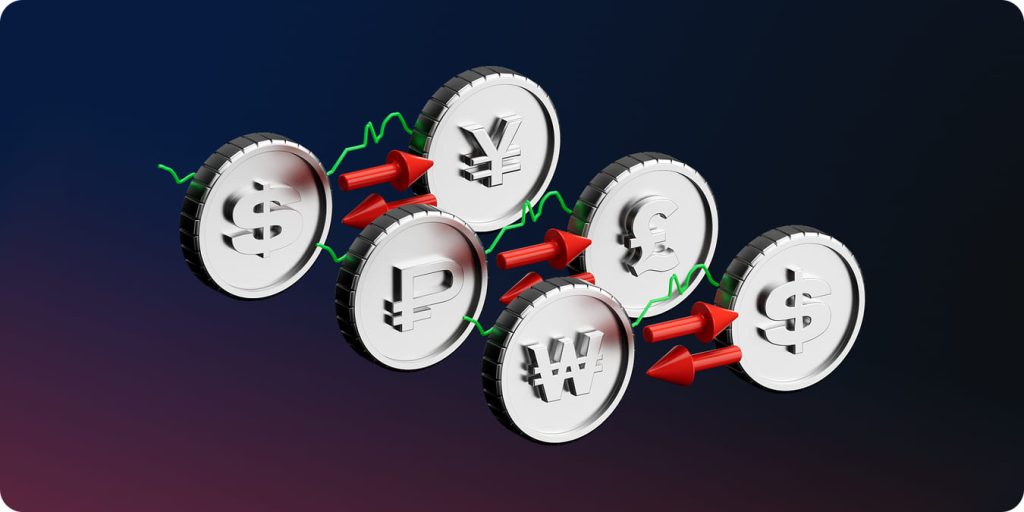
A-Book vs B-Book vs Hybrid Brokerage Models Comparison
Contents
A-Book, B-Book, and hybrid models are trade execution methods used by brokers to manage client orders and risk. These models represent the different ways that brokers will execute trades for their clients, and provide the storyline for the trading firms to use to hedge or not hedge the risk related to client orders. The execution models shape the broker’s relationship with the market as well as how they generate revenue, how they manage their conflicts of interest, and how they indirectly influence traders’ results and the broker’s profit margins.
A vast selection of players exist within the financial markets and the trading industry. Brokerages are like the engine that drives connections to the market. Among the few methods of execution that are well understood include the most common A-Book and B-Book execution models, as well as Hybrid brokerages and each of which offers a different model of operation with a different logic, risk, and ethics.
For anyone with future plans to open a brokerage or for traders who are evaluating how their broker operates, it is essential to have an understanding of these three models. The selection of a model will determine transparency, broker-client relations, compliance, and prospects for long-term success in the trading environment that is growing ever more competitive in the digital space.
Key Takeaways
A-Book, B-Book, and Hybrid models are three distinct ways that brokers can execute trades and transfer risk through clients.
- A-Book brokers, as the name suggests, pass the execution of trades to liquidity providers, creating clear transparency and aligning the brokers’ interests with that of the trader.
- B-Book brokers “internalize” trades, in-house clients positions, earn money through spreads and risk management while performing regulated activity requiring sound internal controls to promote fairness and client confidence.
- Hybrid brokers employ both models to create a higher amount of control through client profiling and smart routing – brokers do need to balance transparency, risk control and profit.
- One thing to note is that technological innovation combined with evolving regulation in 2025 will drive brokers to become more automated, auditable and with variation in client execution.
- Ethics, transparency, and compliance have only become increasingly critical as brokers being to develop trust with clients and move towards sustainability and continuous growth.
A-Book vs. B-Book vs. Hybrid: Key Differences
Deciding which brokerage model is right for you, or understanding how your broker functions, begins with understanding the fundamental differences in execution types. The table below summarizes the structure, purpose, and suitability differences between A-Book, B-Book, and Hybrid Models.
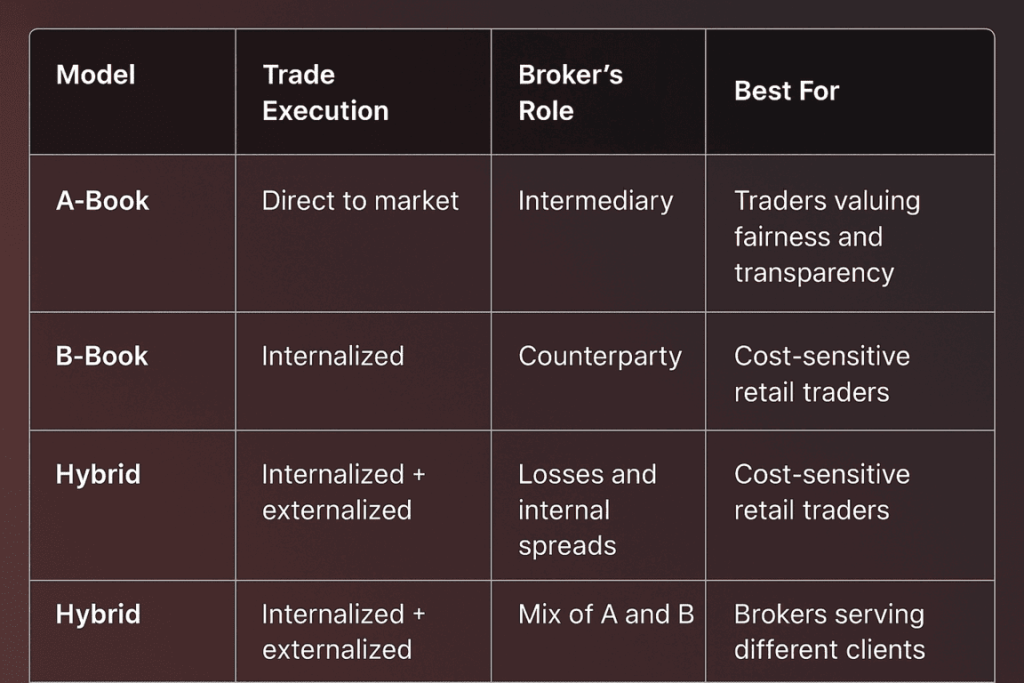
Each model comes with trade-offs in terms of transparency, risk, and profitability. Understanding these differences is essential for selecting the right partner or designing the right brokerage structure, which we’ll touch upon in the next block.
Different Brokerage Models
To navigate the realm of finance it is imperative to have a complete understanding of how brokerages function and what sets each model apart. Acting as a link between brokers and traders, a brokerage serves as the foundation of the trading process. The brokerage is accountable for ensuring a trading experience and customer satisfaction. The manner in which a broker executes trades manages risks, upholds transparency and ensures fairness hinges on the chosen brokerage model.
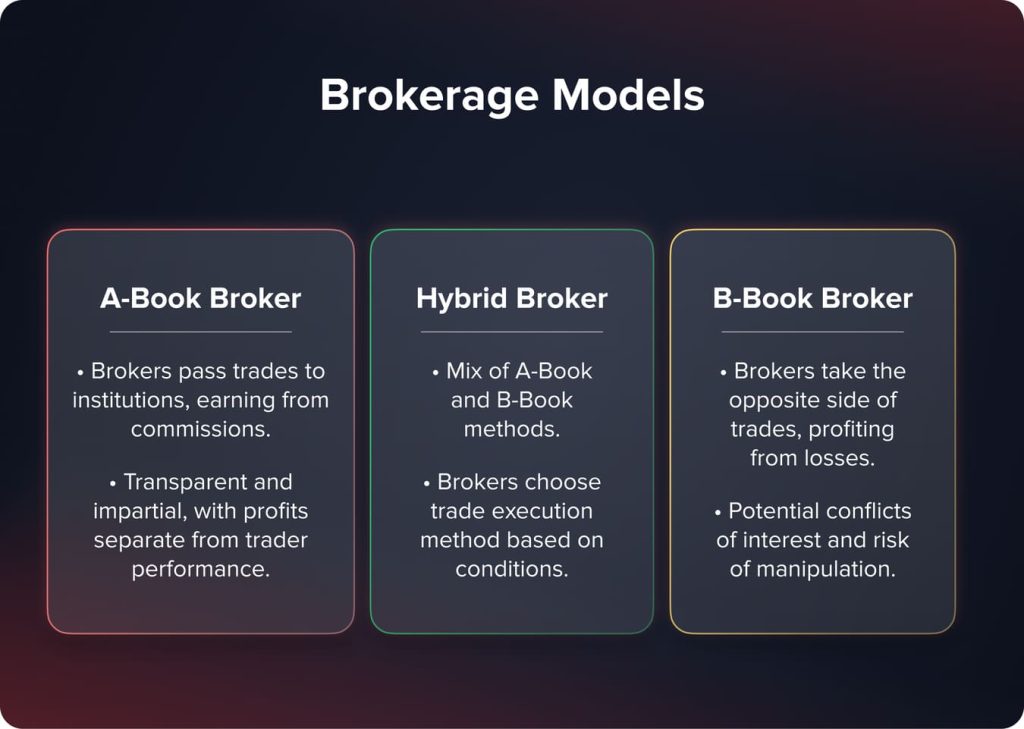
Therefore it’s crucial to delve into each model examining the inner workings, advantages and disadvantages.
A-Book Brokerage Model
Let’s start by looking at the A Book model, where the broker’s role is straightforward; they simply transmit traders orders to financial institutions, like banks as an intermediary. In this setup the broker doesn’t counter the traders position. This approach is also called the Straight Through Processing (STP). The brokers’ earnings solely stem from commissions and spreads rather than trading activities, promoting transparency. Since the brokers profits are independent of traders performance they can maintain an impartial stance in facilitating trades.
You may also like

B-Book Brokerage Model
Conversely the B book brokerage model operates in contrast to the A Book. Here the brokerage does take opposite positions to those of traders. For instance if a trader goes long on a market position, the broker takes a position and vice versa.
If the trader performs well, the brokerage loses money. If the trader experiences losses, then the brokerage profits. This situation can lead to a conflict of interest, as the brokerage benefits from traders losing their trades. While managing all risks internally by not sending trades to another institution has its advantages, it could also encourage behaviors such as stop loss hunting and price manipulation that negatively impact traders. Such practices may make it challenging for this model to attract a customer base and highlight the importance of maintaining levels of transparency.
Hybrid Brokerage Model
The Hybrid model combines elements of both the A book and B book models. In this scenario the broker has the flexibility to decide whether to execute orders through an institution or handle them in house. This decision depends on factors such as market conditions, trader profiles and risk management strategies implemented by the broker.
The Hybrid model aims to combine the transparency of the A book model, with risk management to the B book model.
A/B-Book Myths and Reality
There are many misconceptions about brokerage models, particularly with newer traders, and the truth about A-Book, B-Book, and Hybrid models can help you make educated choices and develop trust with your broker.
Myth 1: A-Book Brokers Don’t Make Profits
Reality: While A-Book brokers don’t profit from losses, they profit on spreads, commissions, and volume rebates from liquidity providers. So, the focus of A-Book is on earning profits through trade volume, spreads, and commissions.
Myth 2: B-Book is misunderstood
Reality: Sometimes there’s a misconception about B-Books containing unethical elements. However, that is not the case in reality, and there are plenty of well-regulated brokers that use B-Books and operate with standards of fairness, transparency, and risk management. The issues only might arise when brokers engage in real unethical practices such as stop hunting or manipulating prices, which are strictly prohibited by reputable regulators.
Myth 3: Hybrid Models are simply out-in-the-open B-Books
Reality: Certainly, some poorly structured hybrid brokers could exploit a hybrid model. However, a properly structured hybrid brokerage can clearly communicate to clients that they are effectively combining A-Book and B-Book logic while trying to achieve a balance or equilibrium in risk and profitability. Most advanced brokers are performing profiling and analysis on their clients, hedging dynamically in different ways, and executing trades using different technologies in real-time, all without sacrificing clarity, fairness, or transparency.
Short History of Brokerage Models
Over the last twenty years, the brokerage industry has undergone tremendous changes due to technological development, regulation, and the particular needs of traders themselves. It is essential to understand how brokerage has changed over the years for which to understand the current state of today’s brokerage model.
Early 2000s: Dealing Desk Broker Dominance
In the early 2000s, most retail trading happened through face-to-face dealing desk brokers (market makers). Dealing desk brokers would execute client trades internally, allowing them to manage pricing and risk while making a profit. Unfortunately, this also created a conflict of interest, leading to a lack of transparency and ultimately trader dissatisfaction. Calls for more lasting execution practices began to grow.
Mid-2000s to 2010s: STP, ECN, & A-Book implementation
Advancements in technology and regulatory modernization led to the acceptance of Straight-Through Processing (STP) and Electronic Communication Networks (ECN). This gave way to the A-Book model, which allowed brokers to pass client orders to a liquidity provider, reducing the inherent conflict of interest, while facilitating previously unobtainable liquidity and aggregation diversity because of improved transparency.
2020s: Hybrid brokerage models
By the time we reached the 2020s, brokers increasingly required intermediaries who had flexibility in adjusting accordingly to the varied types of clients they handle, along with the innate business risk that often arose in accounting for each difference in client. Although hybrid models had existed before, hybrid brokerage models created a continuum along which A-book and B-book strategies could exist, depending on a trader’s profile and client type, as opposed to the market context or risk profile.
A major catalyst in developing hybrid brokerage models that were significantly positive was the use of analytics and AI-driven systems that enhanced the ability to increase transparency to match against risk management criteria at a time when costs were allowed to return to more normal rates given competitive conditions.
Evolution of Brokerage Models
The evolution of brokerage models reflects the changing needs of traders and the continuous pursuit of enhancing risk management and profitability for brokers. Initially brokers heavily relied on B Book models using their positions to control risk and secure profits internally. However this method often created unfavorable conditions for traders, leading to a transition towards transparent and equitable trading environments.
In response to this shift the A Book model emerged, promoting transparency by linking traders to the market and reducing conflicts of interest. Although advantageous for traders, this approach posed revenue challenges for brokers, thus giving rise to the Hybrid model. The Hybrid model provided an approach that allowed brokers to optimize risk management and revenue generation while upholding fairness and transparency.
Each model offers its set of benefits, drawbacks and operational processes influenced by the changing dynamics within the trading industry.
As we explore further into each model in the following sections, traders and brokers will gain insights to help them choose the model that best fits their trading strategies, ethical considerations and financial objectives.
A-Book Brokerage Model
The A Book model serves as a bridge connecting traders with the markets. In this model brokers relay traders’ orders directly to liquidity providers, including banks, major institutional brokers and other financial entities. Instead of taking positions opposite to their clients’ trades, brokers in this framework primarily act as intermediaries.
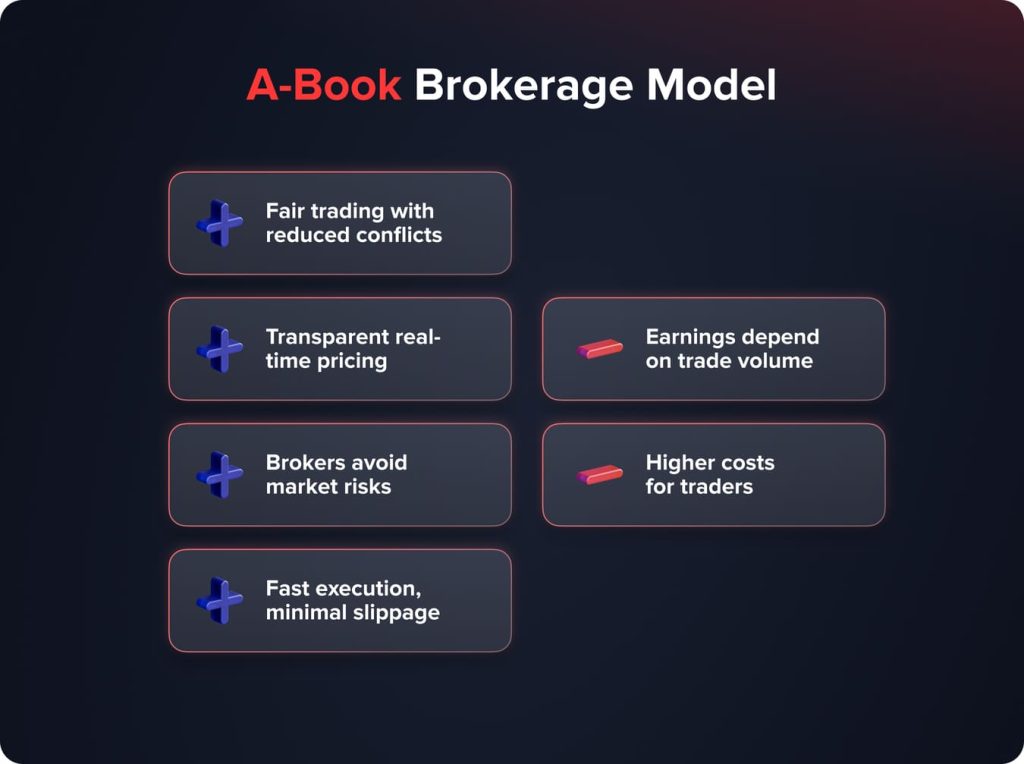
In the A Book model larger financial institutions play a role by offering market options and ensuring efficient order completion. They enable real time market prices and trade execution, promoting transparency and credibility within the trading environment.
Pros of A-Book Brokerage Model
One of the benefits of the A Book brokerage model is establishing a fair trading environment. By transmitting trades to liquidity providers or interbank markets without opposing traders positions this system reduces conflicts of interest. This is perceived as a more equitable approach.
Traders have the opportunity to access market data and view buy and sell prices, which is essential for those who heavily rely on market analysis for their trading strategies. This transparency fosters a sense of trust between the broker and the trader, which is vital for long term success in the trading industry.
Another key benefit of the A Book model is its capability to protect brokers from market risks. In contrast to the B Book model where brokers are exposed to profits or losses from traders positions, the A Book model mitigates this risk by directing orders to liquidity providers. This ensures that brokers earnings remain unaffected by market fluctuations or traders’ wins or losses. Such a risk averse strategy proves valuable in times of high market volatility safeguarding the stability of brokers.
You may also like

Additionally the A Book model enables diverse market access while offering execution speeds to minimize slippage. This swiftness and efficiency hold importance for traders utilizing strategies like scalping, where profits often stem from exploiting price variations over a brief period.
Cons of A-Book Brokerage Model
Nevertheless despite its advantages, the A Book model does come with its set of difficulties.
Relying solely on commission and spread based revenue can pose challenges for brokers as their earnings are more closely linked to trade volumes than the profits or losses from trades. In times of trading activity or market standstill, brokers may face a decrease in revenue flow, affecting their profitability. This limitation underscores the importance of building a client base and implementing client retention tactics.
For traders operating under the A Book model, commission and spread costs may be relatively higher leading to increased trading expenses. This setup might not be financially viable for traders with smaller accounts or those who prefer trading in large quantities. It is crucial for such traders to carefully evaluate the cost implications to ensure that trading expenses do not outweigh profits.
B-Book Brokerage Model
The B-Book model represents a distinct operational strategy where brokers effectively act as the counterparty to their traders’ positions. In this model, instead of routing orders to external liquidity providers, brokers keep the trades in-house, potentially profiting from the traders’ losses.
To manage the risks associated with this model, brokers employ sophisticated risk management strategies and algorithms. These tools help identify and segregate trading accounts based on their risk profiles, allowing brokers to hedge certain positions externally if they deem the risk to be too high, ensuring the broker’s financial stability and sustainability in volatile market conditions.
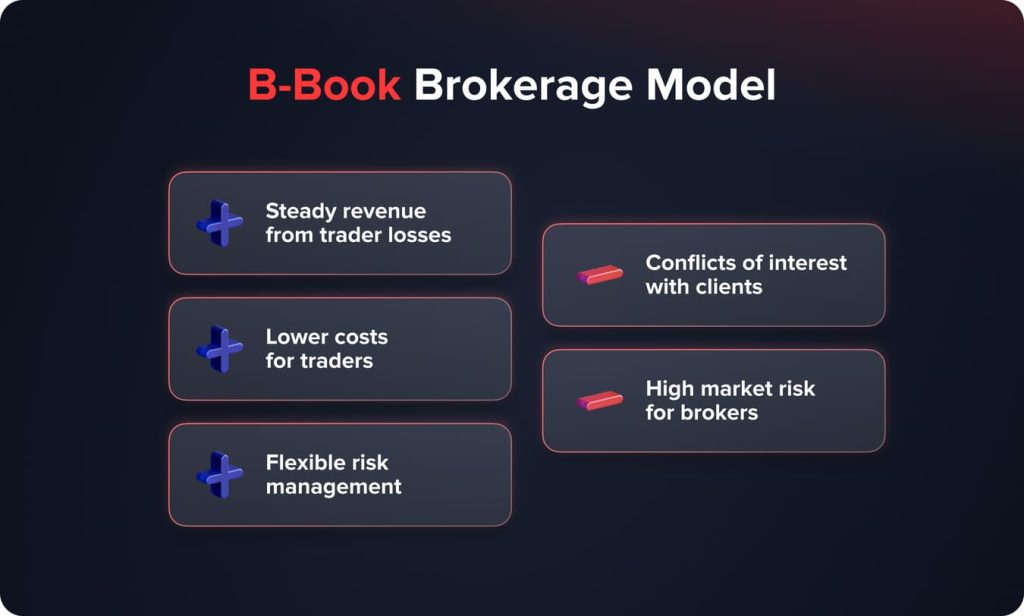
Pros of B-Book Brokerage Model
The B-Book Brokerage Model allows brokers to act as market makers, creating a distinct internal market for their clients. This approach provides a substantial opportunity for profit, as brokers can benefit from traders’ losses, offering a consistent revenue stream independent of market conditions or trade volumes. This means that even in periods of low market activity, brokers have the potential to maintain stable revenue generation.
Another benefit is the ability to offer reduced transaction costs, especially appealing to traders with limited account balances. By managing the market, brokers can provide spreads and lower commissions, making trading more accessible and financially feasible for a wider range of traders. This cost effectiveness is vital for traders aiming to maximize profits while minimizing expenses.
Moreover the flexibility and the control inherent in the B Book model empower brokers to effectively manage their risk exposure. They can adjust spreads and leverage offered to traders based on risk evaluation ensuring a regulated trading environment. The ability to adjust offerings in time is crucial for maintaining broker stability and reducing losses.
Cons of B-Book Brokerage Model
Yet the B Book model comes with conflicts of interest since brokers directly profit from traders losses. This can create a perception of lack of transparency and distrust, potentially straining the broker trader relationship. Traders may be cautious of broker manipulation and may question the fairness and trustworthiness of the trading environment provided.
Moreover, brokers face market risk as they take positions opposite those of traders. In volatile markets brokers are exposed to large losses if numerous traders make profits. This underscores the need for risk management strategies and constant monitoring to navigate market fluctuations and maintain stability.
Hybrid Brokerage Model
The Hybrid brokerage model ingeniously marries the attributes of both the A-Book and B-Book models, offering brokers a versatile and adaptive operational approach. In this integrated framework, brokers possess the discretion to either pass a trader’s order directly to external liquidity providers or keep it in-house, thus acting as a counterparty.
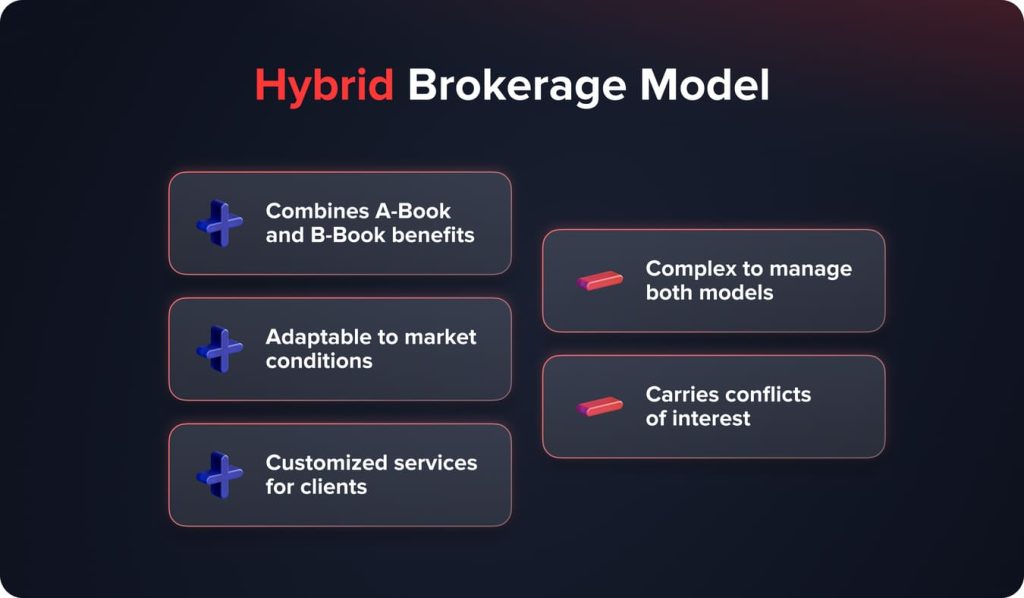
Pros of Hybrid Brokerage Model
The Hybrid Brokerage Model combines elements from both the A Book and B Book models to capitalize on their benefits. This blend provides brokers with an approach to managing risk and generating revenue efficiently. By evaluating market conditions, trader profiles and risk levels brokers can seamlessly switch between A Book and B Book operations to enhance profitability while reducing exposure.
The flexibility of the Hybrid model allows brokers to cater to diverse clients with varying trading preferences, offering customized services that boost customer satisfaction and loyalty. By aligning their strategies with traders’ needs and market trends brokers can create a harmonious trading environment.
Cons of Hybrid Brokerage Model
Managing both A Book and B Book operations concurrently presents hurdles. It demands technology, sophisticated risk management tactics and continuous monitoring for integration and execution of both models.
The Hybrid model is quite intricate and demands planning, execution and oversight. Additionally, it carries over the conflicts of interest from the B Book model. Striking a balance between transparency, fairness and profitability poses a challenge that requires consideration and effective communication to uphold trader trust and satisfaction. Brokers must navigate these dilemmas with care to maintain a fair trading platform.
Emerging Brokerage Trends in 2025
In 2025, brokerage models will have evolved to accommodate rapid technological advancements, increased regulations, and higher client expectations. Brokers that position themselves to meet these challenges will attract a broader range of clients and operate profitable businesses sustainably.
AI-Powered Execution and Intelligent Risk Routing
As of 2025, AI and machine learning will not be optional – they will be essential to how leading brokers do business. Leading brokers will use AI to:
- Dynamically alternate between A-Book and B-Book routing based on real-time client behavior and volatility.
- Automate client risk profiling, as well as the updating of margins.
- Improve internal hedging accuracy and minimize exposure to higher-risk trades.
AI-enabled models not only increase execution efficiency but also provide brokers with the scalability to continue to increase operations while properly maintaining compliance standards and performance.
Client Segmentation & Personal Execution Models
The traders of 2025 will be better informed and more diverse than ever. Brokers have started to move away from generic execution to adaptive, personalized brokerage models based on:
- Experience level (beginner vs professional)
- Risk tolerance
- Product preferences (FX, crypto, CFDs, etc.)
The movement toward personal execution is already leading to hybrid models, using behavioral data and trading history to route orders intelligently, as well as unique pricing, leverage, and trading conditions.
Regulation-Made Transparency and Auditability
New regulation, as well as ongoing evolution of regulation, such as post-MiFID II changes in the EU, the SEC’s pending new digital monitoring regime for brokers in the USA, and ASIC’s new client money reform in Australia, is intensifying the monitoring of trade execution, fund segregation, and reporting practices. By 2025, brokers will have to:
- Offer fully auditable trade profiles,
- Ensure adequate disclosure on when and why A-Book or B-Book execution takes place,
- Provide greater transparency on pricing models and markups.
Regulated hybrid brokers are investing in compliant infrastructure to ensure that they are not sanctioned for non-compliance wh,ilst also protecting what remains of client trust.
Regulation and Ethical Considerations
In the world of brokerage strict regulations and ethical guidelines play a humongous role. These are established by global regulatory bodies such as the Financial Conduct Authority (FCA), the Commodity Futures Trading Commission (CFTC), and the Australian Securities and Investments Commission (ASIC), to ensure the security and fairness of trading practices. These institutions formulate and enforce rules that brokers must adhere to, ensuring transparency and fairness, and protecting the interests of traders.
Regulations cover aspects of brokerage such as:
- Transparency,
- Leverage,
- Margin requirements,
- Client protection.
These are essential for upholding a morally upright trading environment, and they evolve with changes in markets to address risks and challenges in brokerage operations, underscoring the importance for brokers to stay informed and compliant.
Ethical Considerations in Brokerage Models
Brokerage models come with their unique operational characteristics that bring forth specific ethical dilemmas, especially concerning conflicts of interest and maintaining trust in broker-trader relationships.
- A-Book Model
In A-Book models, brokers act as neutral intermediaries that simply execute a client trade and pass it along to an external liquidity provider. As the broker acts as the intermediary in the trade, the conflicting interests of the broker and trader naturally align and create fairness and reduce the risk of a possible conflict.
- B-Book Model
In a B-Book model, brokers are the counterparty to client trades, and thus make money from clients losses. Thus, B-Book broders should act cautiously and fairly to avoid falling into this inherent conflict of interest trap. An ethical B-Book broker must fully disclose their model and avoid engaging in unethical practices such as price shading or stop-hunting.
- Hybrid Model
Hybrid brokers naturally have a more complex ethics model because they use aspects of the A-Book model and also operate its B-Book. Brokers who use hybrid models must be careful about how and why client orders are routed internally or externally, but they must also be able to treat segments of their client base consistently and fairly. Hybrid brokers need to be transparent and yet have flexibility in operational processes, and they should address related issues of equity and operational protocols to increase clarity through appropriate communication, risk profiling, and solid controls.
The Importance of Ethics and Compliance
Being ethical is an obligation, but it is also a strategic advantage in the competitive world of brokerage in 2025. Brokers who demonstrate transparent execution of trades, treat clients ethically, and also exhibit full compliance with regulatory requirements, may be able to:
- Cultivate long-term trust and loyalty among clients,
- Prevent reputational exposure and regulatory penalties,
- Enlist higher-quality clients in the institutional and professional traders.
Final Thoughts
Having an understanding of the brokerage models, how they work and the ethical considerations associated with them is essential, for both traders and brokers. It’s crucial to choose a brokerage model that matches your trading goals, risk tolerance and the ethical principles of the models to ensure a trading experience built on transparency, trust and mutual respect. Brokers need to align their tactics with requirements and ethical norms to create a fair and transparent trading environment that supports the sustainability and legitimacy of their business. When ethical standards, regulatory guidelines and individual preferences are in harmony it fosters a fair and balanced trading environment that benefits both traders and brokers in today’s markets.
FAQ
Brokers choose their execution model - A-Book, B-Book, or Hybrid - based on a combination of factors, including: The profile and behavior of their client base (professional vs. retail), Regulations, if any, that govern them, and where they are doing business, Their technical capabilities related to smart routing and risk management, Their own risk appetite and profitability goals. Many of today's modern brokers have flexible or hybrid approaches, so they can better serve the diverse needs of traders while managing their own business risks.
Yes, traders can choose their brokers according to the execution model preferred. Brokers usually specialize exclusively in A-Book or B-Book or operate in Hybrid models. Therefore, it is imperative for traders to do their due diligence about a broker’s execution policy and how it relates to their trading strategy, risk tolerance, and level of transparency.
Hybrids are unique because they are a blend of A-Book execution and B-Book execution. This method provides the broker with complete flexibility to navigate risk management and profitability in relation to the current market and profile of the client. The model of execution has to be transparent, and accordingly, the routing decision has to be also transparent and communicated to the clients. A Hybrid model can be appealing to clients, but consider that for some traders, utilizing a pure A-Book broker may give more assurance that execution is indeed impartial.
Updated:
October 9, 2025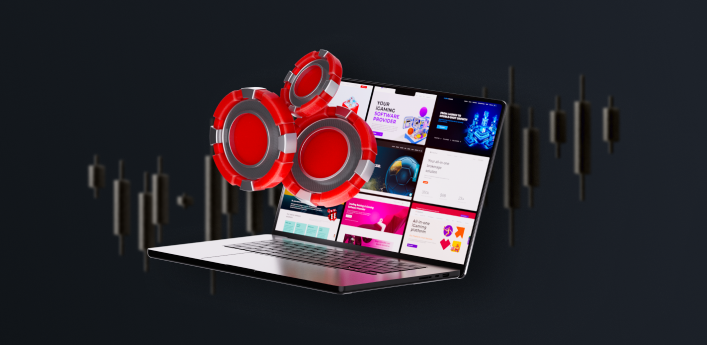
19 December, 2025
Top 10 White Label Casino Providers 2026
A white label casino is a ready-made online gambling platform that lets entrepreneurs start their own brand without building technology or securing licenses from scratch. In 2026, this model remains the fastest and most affordable way to enter the iGaming market. The leading white label casino providers in 2026 are SoftSwiss, BetConstruct, NuxGame, SoftGamings, FintechFuel, […]



